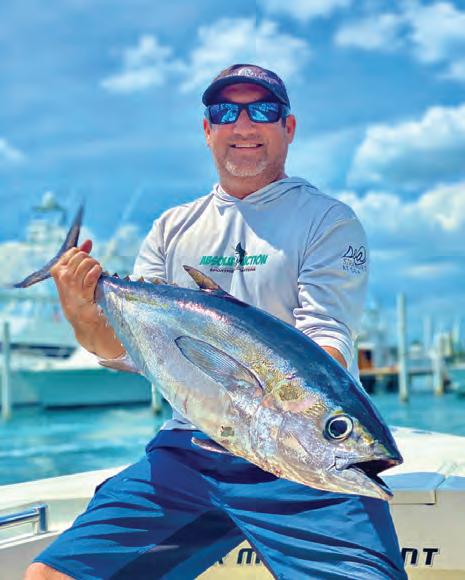










Now stronger and even more durable - the PENN® Battle® IV continues its tradition of being the workhorse of saltwater spinning reels. Newly upgraded with the Hydro Armor™ System and additional seals, the Battle IV is even more protected against saltwater intrusion and corrosion. An updated design eliminates through-holes in the spool body to further protect the reel from unwanted debris infiltrating its body and handle. Available in nine sizes and select high speed models, you can count on the Battle IV to have your back in any fight. PENN. LET THE BATTLE BEGIN™
By Ben Martin, Editor in Chief
Angling is more than just catching fsh—it’s a deeply rooted tradition that transcends generations, embodying a way of life, an art, and a profound source of pride. Tis pride isn’t merely in the size of the catch but in the entire experience, the skills refned over time, and the deep connection with nature.
Central to this pride is the mastery of technique. Whether it’s fy fshing in a mountain stream, casting a net in coastal waters, or patiently waiting with a rod and reel on a quiet lake, angling techniques require patience, practice, and a deep understanding of the environment. Anglers take pride in perfecting their skills—learning to read the water, understanding fsh behavior, and selecting the right equipment. Each successful cast, cleverly tied knot, and well-chosen lure is a testament to an angler’s dedication.
Te true pride in angling lies in the knowledge gained through experience. Seasoned anglers refect on the countless hours spent mastering their sport, from how a fy lands on the water to recognizing subtle signs of fsh activity. Angling is a journey of continuous learning, where each

trip ofers new lessons and insights, further fueling this pride.
Angling also nurtures a deep connection with nature. Being out on the water, enveloped in tranquility, allows anglers to develop a profound respect for the environment. Pride in angling is ofen linked to this connection, as anglers feel a sense of responsibility toward preserving waterways and fsh populations for future generations.
Tis respect for nature is vital to the angling tradition. Anglers ofen become conservation advocates, understanding that their sport’s enjoyment is tied to the environment’s health. Tus, pride in angling also includes a commitment to sustainable practices, ensuring that fsh stocks are maintained and habitats remain unspoiled.
For many, angling is a tradition passed down through generations. Te pride in angling is not just personal but a continuation of family or community heritage. Memories of fshing trips with parents or grandparents are cherished, and the skills learned are ofen passed on to the next generation. Tis sense of continuity creates a

bond that is both personal and collective, linking individuals to their past while forging connections with future anglers.
Te pride in being part of such a longstanding tradition is immense. Anglers feel a deep responsibility to honor the practices and ethics taught by their predecessors; ensuring the spirit of angling is preserved. Whether teaching a child to tie a knot, sharing stories of great catches, or passing on the secrets of a favorite fshing spot, the pride in angling is about nurturing a love for the sport that endures across time.



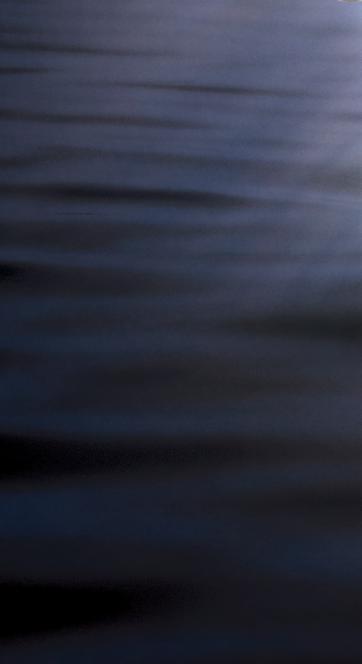








You’re looking at it! Furuno’s award-winning Radar gives you clarity & target separation like no one else. Don’t take our word for it. See for yourself. Scan here, and we’ll show you! DRS4DNXTDRS6ANXT





Selecting the right cast net is crucial for successful fshing. Here are a few tips to help you choose the best net for your needs.
1. Water Depth
Water depth afects the size of the net you should use. In shallow waters, opt for a smaller net with a shorter radius for easier control and retrieval. For deeper waters, a larger net covers more area, increasing your catch potential, but it may be harder to handle.
2. Targeted Fish Species
Te type of fsh you’re targeting determines the mesh size you need. Smaller fsh, like baitfsh or shrimp, require a smaller mesh to prevent escape. Larger fsh beneft from a larger mesh, which reduces water resistance and prevents the fsh from tearing the net.
3. Casting Ability
Your skill level should infuence your choice of net. Beginners should start with smaller,

lighter nets, which are easier to cast and control. Experienced anglers might prefer larger nets that cover more area, though they require more strength and technique.
4. Strength and Weight
may lack durability.
5. Mesh Size
Representatives from Tennessee Wildlife Resources Agency, Tennessee Department of Tourist Development, and Tennessee State Parks celebrate the ribbon cutting of the Bill Dance Signature Lakes project at the Bassmaster Classic in Knoxville on March 25, along with the project’s namesake. Photo Courtesy of the Tennessee Department of Tourist Development:
Balancing strength and weight is key. Te net must be strong enough to handle the catch but light enough for comfortable use. A heavy net can quickly become tiring, while a too-light net
Choose a mesh size based on the fsh species and environment. Smaller mesh sizes are better for small fsh, while larger meshes suit bigger fsh and allow the net to sink faster.
By considering water depth, target species, casting ability, and net strength, you can choose a cast net that enhances your cast netting success.




























Embarking on the open water is an exhilarating experience, flled with the promise of adventure and relaxation. Whether you’re a seasoned sailor or a weekend cruiser, protecting your vessel with proper insurance is not just a choice—it’s a necessity. Explore the reasons why every boat owner should prioritize boat insurance for a worry-free voyage.
The open water can be unpredictable, with unexpected storms, collisions, or other potential accidents. Boat insurance can give you fnancial protection if there is damage to your vessel, providing coverage for repairs or replacement.
Accidents on the water can result in damage to other boats, docks, or even injuries to passengers. Boat insurance offers liability coverage, which can pay for damages or injuries you’re liable for while boating, up to specifed limits, and lawsuit costs if you’re sued. This includes damage you cause to another watercraft or if someone on or near your boat is injured and you’re found to be legally responsible.
Unfortunately, boat theft and vandalism are realities that boat owners face. Boat insurance has comprehensive and collision coverage that can protect you against events outside of your control, including theft and vandalism.
Accidents on the water may lead to injuries for you or your passengers. Boat insurance offers a range of optional medical payments coverage limits, helping to cover medical expenses if you are in an accident or someone is hurt on your boat, regardless of fault.
If you fnanced the purchase of your boat, most lenders require insurance coverage to protect their investment. Having boat insurance not only fulflls these requirements but also gives you peace of mind knowing that your fnancial interests are safeguarded.


Some water municipalities and marinas may require proof of insurance for docking or accessing certain areas. Boat insurance allows you the fexibility to explore different destinations without worrying about entry restrictions.
Emergency towing and assistance
Progressive boat insurance can include optional Sign & Glide® On-Water Towing coverage. If your boat is disabled or breaks down on the water, Sign & Glide® pays for on-water towing, jump starts, soft un-groundings, and fuel delivery.
Wreckage removal
If your boat sinks, Progressive boat insurance will cover the cost of removing your boat from the water (if removal is legally required).
Investing in boat insurance is not just about protecting a valuable asset; it’s about safeguarding the memories, experiences, and joy that come with your on-water adventures. Don’t let unforeseen circumstances disrupt your journey—navigate with confdence, knowing that Progressive boat insurance has you covered. Ensure a smooth and worry-free voyage, because when it comes to your boat, peace of mind is the ultimate luxury.
Scan to get a quote in as little as 4 minutes
learn more.























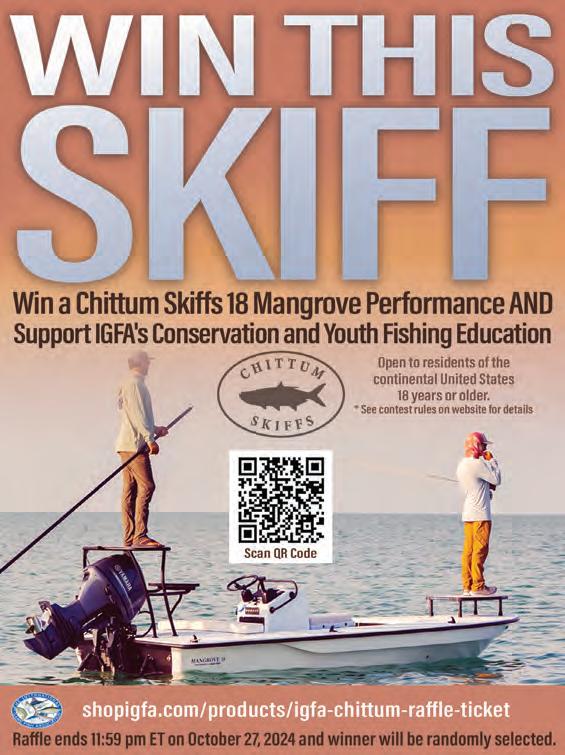



ITim Barefoot
t’s kinda like the old Byrds song “For everything, there is a season…”
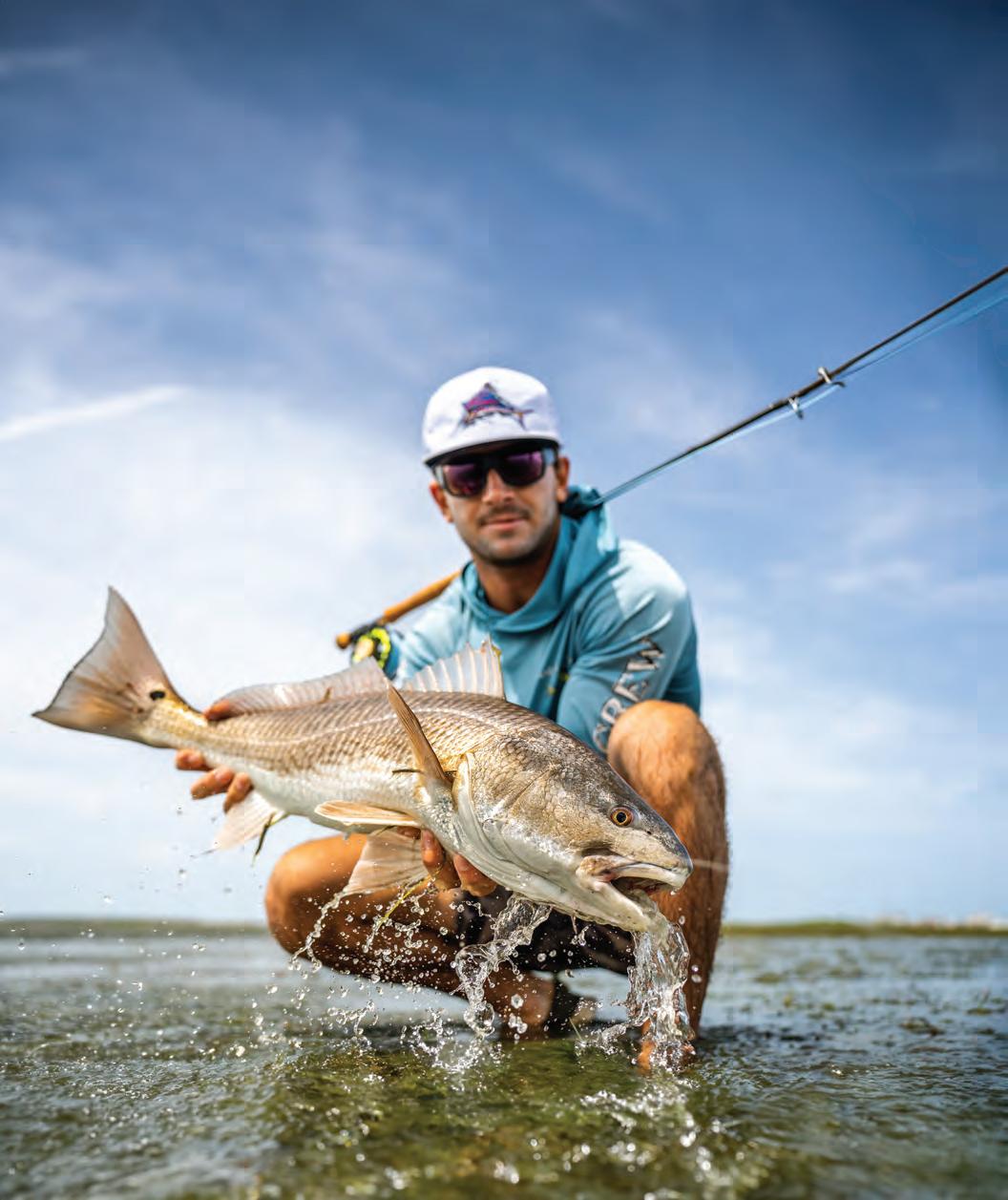

It could not be more true for the month of October, and the season for the shrimp, white shrimp to be specifc. Te (white) shrimp will start to “march” from the sounds towards the inlets and into the ocean. Tey will do this march against the current towards the ocean at night mainly. Tis is the very reason we fsh and catch shrimp at night. With the new LED lights, you can produce hundreds and even thousands of lumens with very low wattage/battery drain.
Do your own research, but I’ve found the Illumisea brand to be cost efective and super bright. When you fre up the lights, you will attract the shrimp. When you have the shrimp, you have the fsh. Pretty simple concept. I’m not saying the fsh will not eat mullets, menhaden, cigar minnows and sardines, or whatever is prevalent in your location, but what I am saying is they will key in on the shrimp and become pretty darn picky if there are a lot of shrimp present. Tey don’t have to be huge shrimp,


just a shrimp. I have seen really nice trout eating (keying on) the very small ones at times. If you can fnd the large 15-18 count then you’re good to go for whatever you want to catch. We call these “Tarpon Selects”. Everything in the water will eat these, from the average sized trout and drum to the largest snook and tarpon. Period. It’s the king of all baits, and October is the month to make the most of it.
For more information, visit barefootcatsandtackle.com and check out his YouTube channel.



By Jeff Durniak | Unicoi Outfitters
October signals the unofficial start to the pumpkin spice craze. Let’s hop on the bandwagon and put this annual phenomenon into trouting terms. First, the pumpkins. They’re going to be the October caddis emergence. These large (#12-14) bugs hatch sporadically throughout the day but fall trout will remember those large groceries and key in on them. Toss a #14 orange stimulator or elk hair caddis into daytime shade or evening shadows for some topwater fun.
Next is the spice. That’s tiny bugs in low, clear, slow water. Be ready for the fall hatches of blue wing olives (BWO’s) and those dreaded, minuscule midges. Carry some BWO’s in sizes 22-24 and midges even smaller if you can find or tie them! My least favorite hatch is those dreaded #30 cream midges. My #24 midges were refused last fall, so I’m going to try to find or tie some flies this year small enough to match those tiny spices! Those tidbits are too tiny to see on the water surface, so drop them off the back of a bigger, visible dry fly via two feet of wispy 6X or 7X tippet. That larger lead fly can be your “pumpkin” pattern, above, or a #16 parachute
adams
Be ready for some fine topwater action in flat, glassy pools this month. This pumpkin spice recipe might just help you score more October treats than tricks!










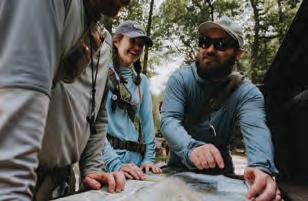






Contributed By: Chris Scalley
Most southern trout waters have sporadic hatches at best compared to the Northeast or out West in the Rockies where the dry fly bite is consistent. Typically, good dry fly fishing occurs when hatches of mayflies, caddisflies and stoneflies are heavy, drawing fish to surface with regularity. On the Chattahooch-
ee we mostly fish nymphs as our hatches are not numerous enough to present just dry flies. Late Summer and fall is when our land based bug populations like ants, grasshoppers and beetles become numerous. As we approach fall, the cooler evenings in the 40’s and 50’s cause these land-based insects to become

lethargic and clumsy along the many miles of shoreline along the river. This fall try some terrestrial patterns. You may be pleasantly surprised what hits your surface fly.















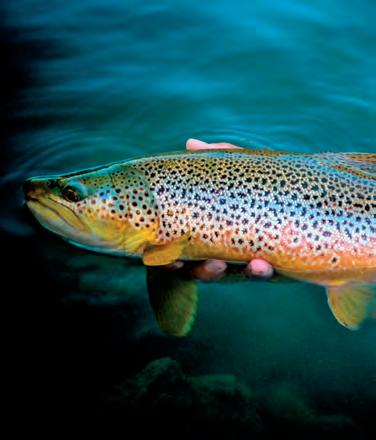

By Capt. Cefus McRae | Nuts & Bolts Fishing Series
Hartwell, GA
When it comes right down to it, most fishermen have too much “stuff”. At least, that’s what my wife and kids tell me. And they’re probably right. I’ve got dozens of rods. Dozens of reels. Hundreds of lures and rigs to choose from. Yep, it’s a lot of stuff.
Over the years, I’ve managed to throttle back on the amount of gear I actually take for a fishing trip. But there was a time when I literally loaded the boat with gear, and fretted for hours about whether I had enough stuff for the trip. In almost every case, I used less than onetenth of what I had. So, I learned to scale down and take what I really needed.
I was so focused on leaving no stone unturned, that I really forgot about the basics. All you really need can be on a pretty short list. A good rod with the correct action for the lures and baits you’ll be using. A good reel with a very smooth drag that has been lovingly maintained.
A full spool of line that isn’t 50 years old. And the terminal tackle needed to attach your lures or live baits. That’s about it. Yes, you need pliers, landing net, ruler, etc., but you’ve already got those on the boat no matter where you’re fishing. I’m talking about species-specific gear. And if you give thought to ‘what’ you expect to catch, you’ll gear up with only what you need.



think, and over-pack for a day on the water. Consider what you truly need for winter drop-shotting and call it a day. You can pack a small box with a few variety lures, just in case. But leave the four boxes of buzz baits and topwaters in the garage till spring. Then spend some quality time lubricating your reel, checking your line, inspecting your rod guides for nicks, and watching a few Nuts & Bolts of Fishing episodes at CarbonTV.com.
I’m confident you’ll be happy that you no longer need to dig through twenty tackle bags just to find a swivel. And because you are better organized, you’ll spend more time fishing too. I quit sweating the small stuff years ago, and it’s been working out great so far.
So, the lesson here is don’t over-



Do you see that? Do you feel it? Could it be? Yes! Fall has officially arrived! The leaves are beginning to change. The aroma of pumpkin spice drifts through the air. The cool air is sure to send a shiver down your back. The most beautiful time of year has arrived on Nottely and there’s no better way to experience it than on the lake! As the temperatures cool, the fishing truly heats up. October can be one of the most productive times of the year for quality bass as options are plentiful. October is one of the few months that we see consistent largemouth activity out on the main lake. Schools of largemouth roam around some of the flatter points gorging on shad as they prepare for winter. This leads to some of the best, and last topwater action of the year. Fish are spread out doing a lot of different things. So, I usually base my approach on the conditions. On calm sunny days a drop shot and Shakey head are great ways to develop bites. Whether you’re fishing a rocky bank, a point, or docks, the chances of catching fish are very

high. On windy or cloudy days, I will move a lot faster. A spinnerbait, small spook, and shallow diving crankbait are all tremendous options. If all else fails, head towards the backs of the creek with a jerk bait. Much of the shad move to Nottely’s feeder creeks for the extra oxygen supply. As such, hungry bass are sure to follow. Most importantly get out there, soak in the scenery, be safe, and Get Fishing! #Godsgotthis
Lake Nottely: Lake Level: 6 ft below full. Temp: 73 degrees; Clarity: Clear
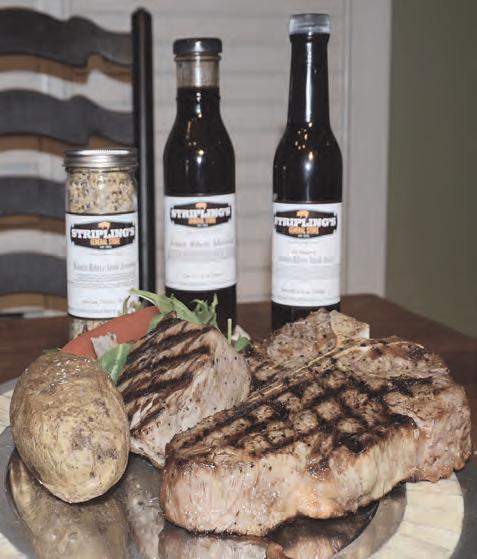








Forecast by: Capt. Clay Cunningham www.catchingnotfishing.com | 770-630-2673
Fall is slowly making its way to the lake. The water temperature is slowly dropping below 80 degrees. The water is clear, and the lake is also slowly dropping from the full pool we enjoyed all Summer. Concerning live bait, herring will continue to be the primary bait in October. Rig the herring on a free line which is basically a 1/0 Gamakatsu Octopus hook, a section of 10-pound Trilene Big Game 100% Flourocarbon and a Spro 120 pd Power Swivel. A quality swivel is important. Use this setup on the same Shakespeare Striper Rod paired with a Penn Fathom II 15 Linecounter you use for down lining spooled with Trilene Big Game. Pull the freeline over shallow points and humps and you will pick up a variety of stripers and spotted bass. October is also topwater month. Be prepared for the surface action with a wide


selection of topwater baits. Spool up a Fenwick medium action rod with 10-pound Trilene Big Game and a Berkley Magic Swimmer as the lure. The Magic Swimmer has caught tons of stripers over the past couple decades. The Magic Swimmer 125 is the most popular size on Lanier. Be prepared with several colors like Chrome and White Liner. Other key topwater baits include the Berkley J-Walker 120, Berkley Surge Shad, and the Berkley Driftwalker. Each one has a different action. The key bait can change daily based on conditions. Two of the key colors are Black Chrome and Bone. Look for schooling fish and cast right in the middle of them. Some of these schools can be massive. This is usually the most exciting month of the year on Lanier. Do not miss it. Hopefully the summer heat will disappear any day now.

Forecast By: Capt. Keith Hudson Keith Hudson Guide Service | hudsonprobass@gmail.com
Bass: FAIR — Expect the lake level to be 5 feet down by September 1st and continue to drop another 5 feet as the month passes. It’s supposed to drop 10 feet by Oct. 1st and stay that way until mid-January, at least. The below normal level is because of repairs needed on the dam. Quite a few ramps should still be accessible, but I would recommend Pyne Road Park on 109. Do not expect to see any fish around grass or weeds in the water at all this fall, although shallow wood and exposed shallow brush piles should hold some shallow bass. Pitch a jig or fish a buzzbait or Whopper Plopper around anything left in the water and hope for the best, if you want to fish shallow. I anticipate a great spoon and drop shot bite this fall because of the low water conditions. Look for deeper brush piles, ledges and roadbeds in the main lake area with the fish basically holding more to a deeper pattern. Water generation always improves this bite. Downsize baits in these same areas & improve your chances for spotted bass. Actively schooling groups of fish will also hit the Flash Mob jr. rig, a personal favorite in the early fall. You can also try targeting the mouths of feeder creeks north of the 219 bridge in the Chattahoochee, BUT be careful with the low water. Do not expect to see much grass or weeds in the water at all, but it could be a great time to learn where the remaining stump rows and timber are. Linesides: FAIR — It has been
a mostly disappointing summer in general for schooling topwater action on the main lake. I still expect decent surface schooling on the main lake at some point this fall. These fish can generally be caught on Roostertails, topwaters, pop n cork rigs and Storm Swim Shad lures. Start early or stay late for the best results. Expect the down-line bite on live bait and the spoon bite to continue to improve as we move toward early fall. Trolling with Flash Mob Rigs should become effective as well, if you like to keep moving. Try old faithful areas like the Railroad Trestle Hump, mouth of WhiteWater and the humps out from Amity Park for good results.
Crappie: FAIR — The fish will typically move out and hold on deeper brush & structure or under docks until the water temps drop into the low 70s or so. Try dropshotting minnows or shooting docks in 10-15 feet of water for the best results. You can really do well if you find one of these schools. Try the cuts & coves in Yellow Jacket creek and from Highland Marina north to Wolf Creek in the Chattahoochee. Some fish will start to move a little shallower as the water slowly cools, maybe by the end of the month. Minnows fished under a float will usually work on them, when you find them. Any blowdown near deep water is a good starting point. Night fishing is still pretty good. Try under the bridges with lights .



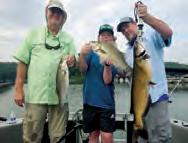





Hybrids / Stripers – The guides here rejoice this time of year! After Labor day, the saying is “The lake is ours once again.” Most recreational boaters have hung it up, water temperatures moderate, and fishing will be good through June 2025.
October should be awesome. For morning trips there is always the chance that Georgia power will be pumping water up from Lake Sinclair. Tie on a popping cork and a Betts “Pop N’ Stripe” Popper and hang on! Casting spoons to them will work too.
For the afternoon bite, stay until near dusk. Troll large bass minnows slowly (.05 to .09 mph if its not too windy). It is a simple set up. A spinning rod and reel, 12lb test to a swivel, then a leader from18 to 24 inches long to a #4 circle hook. Crimp on a #4 sinker above the swivel. Fish on the edge of the river channel.
Forecast for October Crappie – for those of us that like to troll for crappie, trolling can be very good. I put out a spread of 8 rods. I use 6lb test and usually a double jig set up. The first jig is a
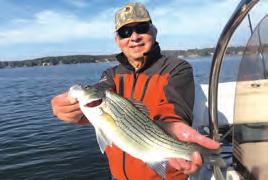
1/16th ounce “Jiffy jig” curly tail jig on a “Litewire hook” jig head. Then, I use a loop knot to tie on a 1/32nd ounce second jig about 3 feet below the first. I usually troll at .09 mph.
Fly Fishing – Finally, the water temperatures have started to cool down. You never know if or when Georgia Power will pump up for Lake Sinclair. It is usually just finishing the first hour after daylight if they do. When they do, fly fishing is awesome. Clousers, Henry Cowen’s “Somthin Else,” or a wiggle minnow will all produce. If you see birds feeding on shad, get there and get ready!
Final Words – Contact me at wmoore1700@outlook.com or call 404317-9556 to book your trip. Fall and winter fishing is great here!





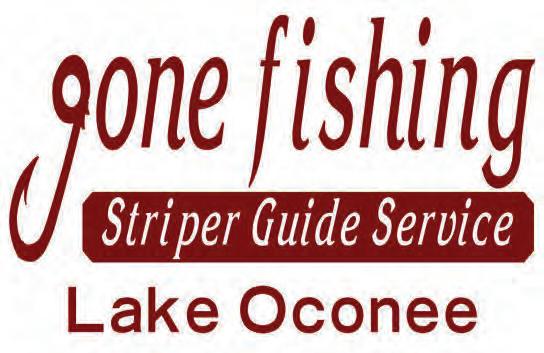







Down-lining live threadfin shad and herring will continue to be a top producer for the striped, hybrid and white bass. Common setups include ML-Medium live bait rods, paired with a line counter reel with a good drag and spooled with a 1220lb test monofilament. A 5–6-foot leader of lighter fluorocarbon (812 lb. test) trailed behind a 1-2 oz. egg or swivel sinker and typically size 4-1 octopus or mosquito hook, depending on actual bait size. Currently, ideal target depths are in the 20-30’ range and above your current thermocline range. Soon the destratification of the reservoir will begin. This makes it a little more challenging for a couple weeks, but persistence will pay off. It is almost always recommended to keep a freeline or two out with a frisky threadfin or small gizzard shad. Sometimes, this is the best technique and is proven to be effective nearly year-round. This may be utilized in conjunction with fishing live bait on the downlines.
Planer board fishing will also have its days. Oftentimes, beginning in October we like to pull some larger baits along deep channel walls and over the flats in the early part of the day hoping for a big bite to get the day started.
We have seen some limited topwater action of the linesides, particularly in the evening hours through September. With the continued change of patterns that the prevalent herring forage base has created, the topwater bite for the linesides may be a little more sporadic, as the young of year herring continue to grow and learn that their survival depends on diving versus being pushed to the surface. Through the past couple years, it has been noted that most topwater activity primarily occurs when the threadfin shad are being pushed to the surface. It is also noted that the young herring will tend to stay schooled up and often ripple the surface. It has been observed that the adult sized herring will tend to dive when danger presents, often causing gamefish
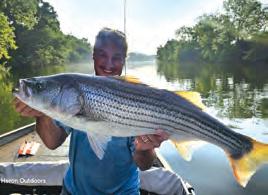

to chase them deeper. Nonetheless, having a topwater setup at the ready can be a setup for success if the boiling begins. Newer riserstyle baits are working well, along with casting spoons and heavier, yet compact topwater baits that have a little reach should the activity be 50 yards away.
Last, but not least, the Umbrella and Alabama rig bite is always an effective method of locating and triggering bites from these white fish across points and humps and will often prove effective during these autumn months. When applied, we have often had the best success on smaller A-rigs pulling a mini-Mack about 100’ behind the boat. Adding an egg weight can often help these slimmer profile rigs achieve deeper depths.
Now, let’s get fishing! We do hope that some information gleaned here will help you get onto a decent bite. If you are considering a full-service fishing adventure with as much instruction as we can provide during our adventure together, we would sure love to have you aboard our boats. We do, in fact, target all species and provide mainly live-bait excursions but a combination of live bait and artificial as well as artificial only trips are on the table. Please do not hesitate to call or message us

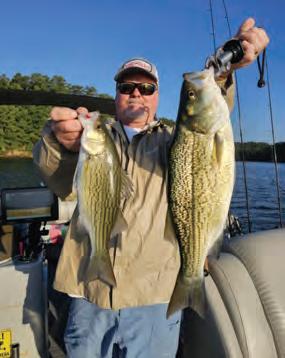


Lake Lanier is 38,000 acres of prime fishing and home to some of the best spotted bass and striped bass in the world. There are dozens of hotels within minutes of the lake, professional fishing guides to increase your odds of catching the “big ones” and plenty of action in Gainesville, Georgia to keep the family entertained! Check us out at ExploreGainesville.org to find out more.









































Fall fshing ofers anglers a perfect blend of cooler weather, stunning scenery, and active fsh. As summer fades, the changing conditions in freshwater and saltwater environments create ideal opportunities to catch a variety of species. Whether in lakes, rivers, or coastal waters, autumn provides some of the most rewarding experiences for fshing enthusiasts.
One reason fall is excellent for fshing is the behavior of fsh during this season. As water temperatures drop, fsh become more active, feeding aggressively to prepare for winter. In freshwater, species like bass, trout, and walleye move into shallower waters, making them easier to target. Bass, in particular, hunt more during the fall, feeding on schools of baitfsh in cooler, oxygen-rich waters.
Largemouth and smallmouth bass gravitate toward areas with abundant food sources. Anglers ofen succeed using lures that mimic baitfsh like shad and minnows. Crankbaits, jerkbaits, and sof plastics, especially in natural prey colors, are popular choices. Fishing near structures like submerged logs, rock piles, and weed beds can increase your chances of landing a big one, as bass ofen use these areas as ambush points.
Trout fshing also peaks in the fall, with cooler water temperatures bringing these fsh into more accessible parts of rivers and streams. Fly fshing is particularly efective during this time, as trout are more likely to strike at dry fies and nymphs resembling the insects they feed on. In many regions, fall is also the time for spawning runs, particularly for salmon and steelhead, ofering anglers a chance to catch them in large numbers amid stunning autumn scenery.
In saltwater, fall is synonymous with the migration of popular species like striped bass, bluefsh, and redfsh. As these fsh move along coastlines, following baitfsh like mullet and menhaden, they ofer exciting opportunities for surf and boat fshing. Te fall mullet run is a
I’ve spoken with and interviewed many anglers during my career as an outdoor writer. One of my favorite questions is, “Do you remember the frst fsh that you caught?” It’s amazing to me how many anglers do in fact remember the very frst fsh that they ever caught. Most recall every element involved in that frst catch. All seem to instinctively smile when recounting the event. It’s a fond memory, one that glistens each time it’s retold.
Tis right of passage can occur at any age. For me I was four years old standing beside a small pond with a cane pole, red and white bobber and baited hook in the water, with my dad kneeling beside me. I remember that it was a sunny day and that we were both smiling.
As the bobber went under my dad said, “Catch him, Son!” and I instinctively raised the cane pole to bring the brim to my dad’s reach. We put the fsh in a metal bucket full of water and I stared at it and observed it the entire ride home. I remember how proud my dad was as he shared the story of my catch with the rest of our family, and thus began a lifetime of catches and smiles and fond memories and a sense of pride and accomplishment. A lifetime of those wonderful elements thanks to my dad.
Teach a kid to fsh. Tey’ll likely never forget you, and you’ll likely change their life for the better.

highlight for many saltwater anglers, drawing large predatory fsh close to shore where they can be targeted from the beach or pier.
For those targeting striped bass, the cooler fall waters bring these fsh into the shallows, making them more accessible to surfcasters and inshore anglers. Live bait like eels or bunker is ofen the go-to choice, but lures like topwater plugs, sof plastics, and bucktails can also be efective. Te sight of a striper smashing a surface lure in the crisp autumn air is an experience that keeps many anglers coming back year afer year.
Another advantage of fall fshing is the relative solitude. With many focused on hunting or other seasonal activities, fshing spots are less crowded than during the summer. Tis allows for a more peaceful experience, where you can fully immerse yourself in nature. Te vibrant fall foliage, combined with the quieter atmosphere, creates a perfect backdrop for a day of fshing.
Overall, fall fshing ofers something for every angler. Whether chasing bass in a quiet lake, casting for trout in a mountain stream, or battling gamefsh along the coast, fall provides unparalleled opportunities to connect with nature and enjoy the thrill of the catch.
By John Mosley
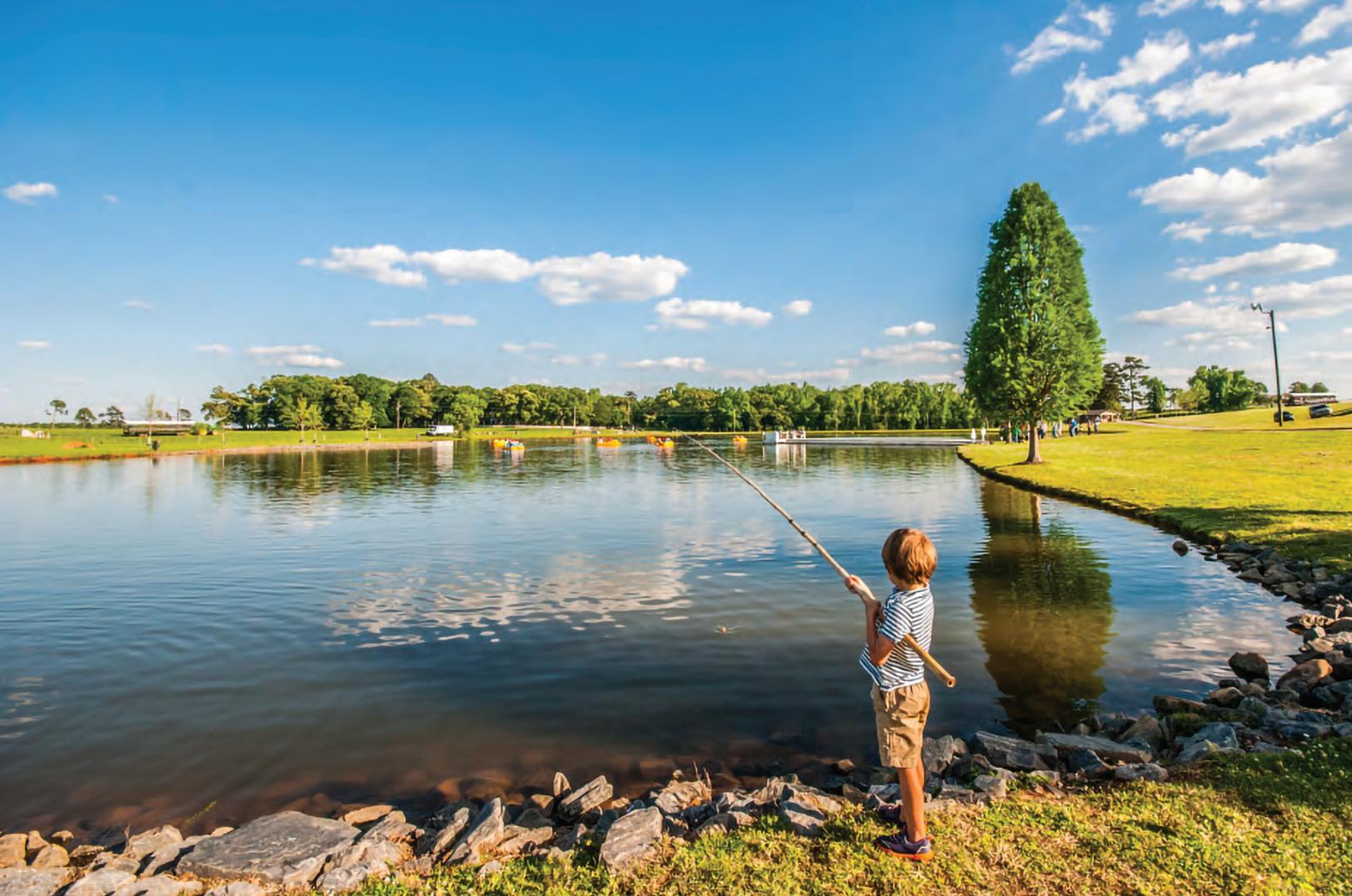




Relentless performance for every yacht, everywhere, every time. It is so much more than just bottom paint.




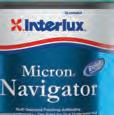







Interlux’s range of fouling control products not only improves your performance by protecting your hull from fouling, they also protect against the spread of invasive species, safeguarding your local waters when exploring new regions, therefore helping you make a difference by looking after the waters that have provided you with enjoyment and freedom for so many years.
Like you, we have a passion for boating. We provide boaters the hull protection they deserve with over 140 years of cutting-edge science, technology and expertise. You can expect only the best from every Interlux yacht paint product, providing you the confidence to explore your world.
Early morning fog and dropping water temperatures are a sure sign fall is near.

Yes, it’s that time of year when the big sheepshead and cool water redfsh invade the local deep-water docks and structures. Both species are tough opponents, challenging even the most skilled anglers.
Sheepshead are most likely to be found around docks where subsurface pilings are covered in marine growth like oysters and limpets, and where tiny crabs live inside. Extreme submerged structures such as rock outcrops or limestone ledges are good too.
Tis time of year, seek the larger redfsh around deep water docks where white bait and pinfsh congregate for protection, becoming a plentiful quarry. Both reds and sheepsheads like to use the current that brings food naturally in their direction, possibly using the pilings as an ambush point from which to launch their attack. Look in the proximity of extended dock systems and/or rough shoreline structure; lots of the bigger fsh are caught here.
Tiny crabs or sand feas will produce great sheepshead action. Live shrimp cut in half are my next “go to” bait. Seek docks with at least eight feet of water (10’ to 14’ is ideal). Cast to the base of the pilings. Ten tighten the line to feel the bite.
Small freelined pinfsh or live whitebait are great for reds as the water cools thru early October.
My neighbor Jerry claims, “Redfsh hate pinfsh. Tat’s why they are such good bait.”



By CAM Staf
Anglers have long observed that fsh activity is infuenced by the lunar cycle, giving rise to what are now known as lunar tables. Tese tables serve as invaluable tools for predicting when fsh are most likely to be active and feeding. But how do lunar phases afect fshing, and how can anglers use lunar tables to their advantage?
A lunar table provides information on the moon’s phase and its position relative to the Earth and the sun. Tese factors signifcantly afect tides, which in turn infuence fsh behavior, especially in coastal and tidal waters. Te moon’s gravitational pull creates tides, and as the water moves, it stirs up nutrients and prey, encouraging fsh to feed.
Beyond tides, fsh have a circadian rhythm that governs their daily activities, including eating and resting. Many species, especially saltwater
“Really?” I said, “Reds hate pinfsh?”
“Yeah”, he said, “Pinfsh eat the redfsh eggs and the reds hate them.”
Now that’s some good information right there! I laughed and replied, “I did not know that!”
Oh well, to each his own.
OK, Jerry, if you say so.
I guess I’ll have to believe him because they do work well.
Cut ladyfsh tightlined on the bottom is always good.
Cooling fall waters are great for many species which include pompano, mackerel, sheepsheads, trout and reds. Find some good structure or a vacant dock and give it a go.
I wish for you a most enjoyable and productive day on the water while in pursuit of your fall quarry.
Capt. Russ Walker is a USCG Masters licensed fshing guide and owner of Tide Walker Charters out of Cape Coral, FL. www.tidewalkercharters.com.
fsh, also follow a lunar rhythm directly infuenced by the moon’s phases. Fish tend to be most active during the new moon and full moon phases, when tidal movements are more pronounced and feeding conditions improve.
1. New Moon: During the new moon, when the moon is between the Earth and the sun, strong “spring tides” occur due to the combined gravitational forces of the sun and moon. Tese heightened tides trigger more active feeding, particularly inshore and near tidal fats.
2. Full Moon: Like the new moon, the full moon also causes strong spring tides. Fish, especially predators, are more active at night during this phase, taking advantage of the increased light for hunting.
3. First and Last Quarter: Tese phases generate weaker “neap tides,” with less pronounced tidal changes. Fishing can still be productive, but fsh activity is generally reduced compared to the new and full moon phases.
Lunar or solunar tables break down the moon’s infuence into specifc time slots for optimal fshing, categorizing them into “major” and “minor” feeding periods. Major periods occur when the moon is directly overhead or underfoot, while minor periods happen when the moon is on the horizon. Major periods generally result in higher fsh activity, although both are useful for timing fshing trips.
Most lunar tables are simple to read, ofen color-coded for clarity. High fsh activity times may be highlighted in green or red, while less favorable periods might appear in blue or gray. By planning your fshing trips around these prime times, you can increase your chances of success.
However, lunar tables are just one factor among many. Weather, water temperature, and the habits of specifc fsh species also play crucial roles. For instance, overcast conditions during a full moon can reduce visibility, hindering feeding, while high winds or changing barometric pressure may alter fsh behavior.
Lunar tables are a valuable tool for anglers seeking to maximize their success. Understanding the moon’s phases and their efect on fsh behavior, especially during new and full moon phases, can help you plan fshing trips during peak activity periods. Although they don’t guarantee a catch, combining lunar tables with local knowledge and weather conditions can signifcantly enhance your chances of a productive day on the water.
Introducing kids to the sport of hunting through squirrel hunting can be an excellent way to nurture a lifelong appreciation for nature and outdoor skills. Squirrel hunting ofers a relatively safe, manageable, and rewarding experience for young hunters. Tese small game animals are abundant and found in many habitats, providing ample opportunities for success, which is crucial for keeping kids engaged.
Squirrel hunting teaches essential hunting skills such as patience, observation, and marksmanship. Because squirrels are agile and quick, young hunters learn to move quietly and hone their ability to spot subtle movements in the trees. Tese skills are foundational for all types of hunting, making squirrel hunting a great starting point.
Moreover, squirrel hunting emphasizes safety and ethics, as kids learn to handle frearms responsibly, understand hunting laws, and respect wildlife. Parents and mentors can use this experience to instill values like conservation, teaching kids about sustainable practices and the importance of preserving natural habitats.
Te physical demands of squirrel hunting are also suited for young hunters. It typically involves moderate walking and the excitement of a successful hunt is an excellent way to build a child’s



confidence and interest in the outdoors.
By Benjamin Babcock
Overall, squirrel hunting is not only a gateway to the broader world of hunting but also a meaningful way to bond with children and introduce them to the principles of responsible, ethical, and sustainable hunting practices.
Te .410 over-under shotgun is an excellent choice for a child’s frst frearm, ofering a combination of safety, versatility, and ease of use that makes it ideal for young or novice shooters. Tis type of shotgun typically has two barrels stacked one on top of the other, which gives it a balanced feel and allows for quick target acquisition, making it easier for kids to handle and shoot accurately.

One of the main advantages of a .410 shotgun is its low recoil. Te .410 is known for being a “light” shotgun, meaning it doesn’t have the heavy kick associated with larger gauges. Tis is particularly important for young shooters, as it allows them to focus on learning proper shooting techniques without the fear of painful recoil, which can discourage continued practice.

Te over-under design also emphasizes safety. With its simple break-action mechanism, it’s easy
carried safely in the open position when not in use. Additionally, the .410’s limited range and pellet spread make it a good learning tool, encouraging kids to develop accuracy and precision.
Te versatility of the .410 makes it suitable for various types of hunting, from small game like squirrels and rabbits to clay target shooting. As a child’s skills and confdence grow, the .410 over-under shotgun can serve as a reliable and consistent companion, helping them build a strong foundation in shooting sports. Overall, it’s an excellent starter gun that balances ease of use with the challenge necessary to develop profciency.




By Capt. Quinlyn Haddon

Throughout the month of October, the fishery in The Florida Keys will begin its autumn transition. This midway point between the drastic change of summer and winter fishing, can be unpredictable to forecast, but also provides exciting surprises during this overlap.
With cooler waters driving fish nearer to shore, reef and backcountry fishing will become more and more productive as we push into our winter fishery. The bait fish that particularly favor our shallower waters as the temperatures drop, will bring with them some of our favorite winter predators. Depending on the timeline of this seasonal change, we may begin to experience the return of sailfish and wahoo near our reef.
The anticipated temperature change of the water not only drives fish closer to shore, but is also a massive trigger for southbound migration. This is especially true for one of the ocean’s most notable vagrant; the swordfish. Fully understanding the habits of a fish that can migrate hundreds of feet up and down the water column each day, and thousands of miles each year,
can be a challenging endeavor. However, the data that has been collected on swordfish to date, has proven to be reasonably consistent.
The majority of mature swordfish, and particularly large breeding females, have been observed to spawn predominantly in the spring and summer. They favor warm waters with heavy currents for this process, which takes them as far south as the Caribbean sea. After abandoning their millions of eggs to the currents, they will begin an incredible migration in search of feeding grounds to sustain them repeating the process all over again.
Traveling thousands of miles up the coast, as far as Newfoundland, Canada, they seemingly utilize the continental shelf has a highway.
After gorging in these northern waters throughout the summer and early autumn, they then begin their return migration through our section of the swordfish highway, opportunistically feeding along the way.
While every month in the Florida Keys provides excellent opportunity to catch swordfish, this month gives us an extra bump on prevalence of larger swordfish migrating through our waters. The same is true for November as well, but with more chances of tackling windier days, October offers a more reliable forecast.
Catching swordfish is a great way to fill the box with a significant amount of quality meat. The yield of a single fish is more than enough to fill both your refrigerator, and when properly sealed, your freezer too. The unique flavor and texture of swordsteaks is sought after on its own, but there is always a chance that your catch is concealing an upgrade. In very rare instances, a swordfish’s meat will appear orange in color as opposed to the standard white. The quality of this meat is unparalleled, and is caused by the fish’s penchant for munching on shrimp. These special upgraded fish are referred to as pumpkin swordfish. How perfectly festive it would be to carve one of these this month.
The Florida Keys not only boasts an excellent fishery for swordfish, but can also get you there in about a 30 mile run offshore. This gives you a chance at a fish at a lifetime in half the time and cost of a west-coast grouper trip.
If this fish is on your bucket list, October in the Florida Keys presents a great opportunity to add that checkmark.
Capt. Quinlyn Haddon guides with Sweet E’nuf Charters out of Marathon, Florida Keys. Contact her at (504) 920-6342 or Captainquinlyn.com. Find her on social @captainquinlyn.







If your device has an LCD that has faded over time, or want to inquire about possible repair options for your unit, give us a call or visit our website!











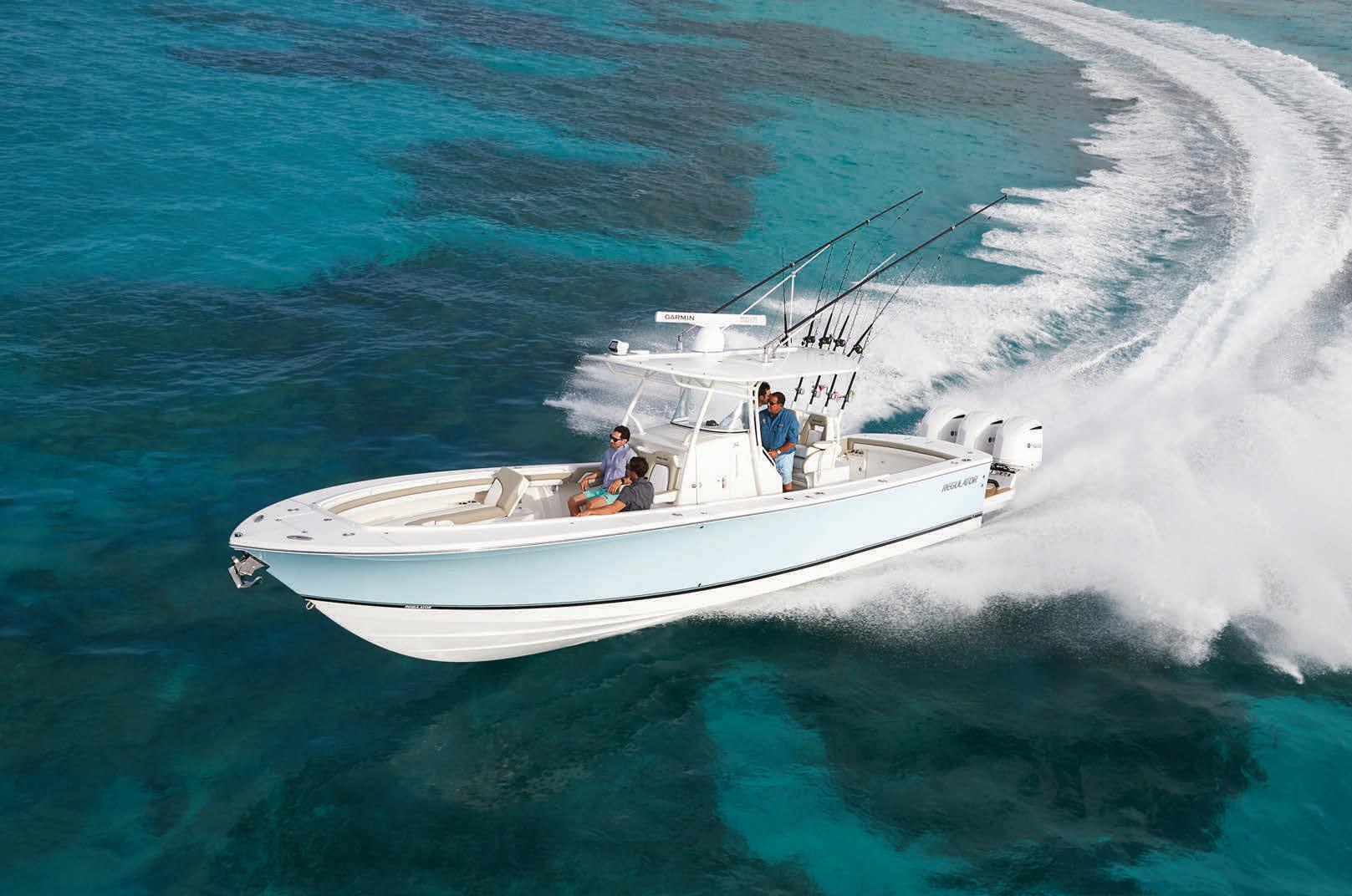




Boat Fix, a recreational boating telematics company that provides a combination of real time remote monitoring, GPS tracking, sophisticated geofencing, and 24/7 live customer support, announced today its Admiral Club Member sponsorship of the National Safe Boating Council (NSBC).
“At Boat Fix, safety is in our DNA and our goal is to promote safe, secure, and stress-free boating,” said Steve Pitsos, CEO, Boat Fix. “To support the NSBC at this level aligns with this vision. We are excited to be a part of the organization and thrilled to help them in their mission of advocating for a safer boating culture.”

“We are very grateful for the support of companies like Boat Fix,” said Peg Phillips, Executive Director, National Safe Boating Council. “Promoting safe boating takes constant education and outreach to the boating community. Only through the support of like-minded companies can we accomplish this vital mission.”
Boat Fix is more than a feet management and monitoring solution. As a tool for safer boating and boat ownership, the Boat Fix app sends real
time weather alerts and small craf advisories including wave height, visibility, and wind speeds based on the boat’s location; ofers geofence protection; safety checklists of U.S. Coast Guard required equipment including calendar reminders with fre extinguishers and fare expiration dates and helps ensure that the correct number of life jackets are on board to be worn; pre- and postdeparture checklists to help verify all systems are functioning properly; as well as remote


monitoring of battery voltage – including ultra-low, low- and high-voltage which is critical for preventing degradation of battery life and avoiding potential fres or explosions. In addition, the Boat Fix app provides advanced navigation with NOAA charts with detailed navigation marks and depths, rather than industrystandard Google Earth maps.
Users of the Boat Fix Pro app can communicate with the 24/7 Boat Fix team at the touch of a button, through voice, text, email, or two-way video chat to answer questions and diagnose issues on the water. Every call is answered in seconds, in person, by trained professionals ready and willing to help. Te industry-exclusive 24/7 Emergency Mechanical Helpline ensures boaters have immediate mechanical assistance over the phone if issues occur on the water. Te 24/7 Boat Fix Control Center also monitors unauthorized use and boat-thef prevention and can share your boat’s exact location with law enforcement.
Founded in 1958, the National Safe Boating Council serves as a national catalyst for developing a safe boating culture by providing educational resources, outreach programming, and training opportunities for industry partners and the boating community to infuence fun, safe, and responsible boating.
By Tracy Patterson

In the last decade, fshing has seen a signifcant transformation with the rise of female anglers. Once a male-dominated activity, more women are now not only participating but also excelling, reshaping the fshing community and breaking down stereotypes.
According to the Recreational Boating & Fishing Foundation (RBFF), the number of female anglers in the U.S. has increased by nearly 20% over the past ten years. In 2020, around 17 million women fshed, making up nearly 40% of all anglers. Tis shif refects broader changes in societal attitudes toward women in traditionally male-dominated activities.
Female anglers are challenging long-standing stereotypes. Fishing, ofen seen as a rugged, solitary pursuit for men, is proving to be a universal activity. Women are demonstrating that anyone can enjoy fshing, regardless of gender.
Social media has been crucial in this shif. Platforms like Instagram and YouTube have allowed female anglers to share their experiences and successes with a global audience. Infuential anglers like April Vokey and Kristine Fischer are showing that women can excel in all aspects of the sport, encouraging more women to try fshing.
Te fshing industry has responded by creating more inclusive products and marketing campaigns. Companies now design gear specifcally tailored to women, such as fshing rods with smaller grips and clothing lines that blend functionality with style. Brands are also increasingly featuring women in their advertising, making fshing more accessible and inclusive.
Te rise of female anglers has also had positive social and environmental impacts. Women who fsh ofen involve their families, leading to an increase in family fshing trips and fostering a love for the outdoors in the next generation. Additionally, women are playing a key role in conservation eforts, advocating for sustainable fshing practices and protecting aquatic habitats.
Organizations like Casting for Recovery are empowering women through fshing, ofering programs that combine the sport with wellness and community-building activities. Tese initiatives introduce more women to fshing while promoting physical and mental well-being.
As more women continue to enter the sport, they inspire further innovation and inclusivity within the fshing community. Te rise of female anglers is a testament to the power of diversity and the enduring appeal of fshing as a sport for everyone.








